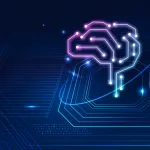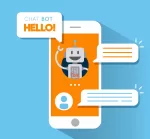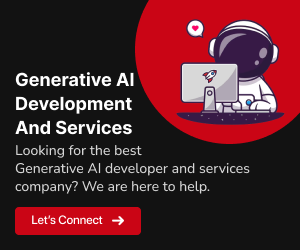In this exploration of Generative AI projects, we’ll delve into the essence of AI and its capabilities, including how it has impacted various domains. Generative AI, as a creative powerhouse, plays a pivotal role in redefining human-computer interactions. These innovative projects empower artists, content creators, and information seekers, expanding the boundaries of creativity and problem-solving. From OpenAI’s GPT-3 to DeepArt.io, AI Dungeon, and more, we’ll clarify the functionalities and applications of the top 8 Generative AI projects, showcasing their transformative influence on art, technology, and the human experience.
What is Artificial Intelligence?
At its core, AI refers to the development of computer systems and software that can perform tasks that typically require human intelligence. These tasks encompass a wide array of activities, such as problem-solving, language understanding, visual perception, and decision-making. AI is not merely about automating processes; it aims to replicate and, in some cases, surpass human cognitive functions.
AI systems, in general, have the following key attributes:
- Learning: AI models can learn from data and improve their performance over time.
- Reasoning: AI systems can analyze data, recognize patterns, and make decisions based on the information they have.
- Problem-solving: AI can tackle complex problems by breaking them down into smaller, manageable tasks.
- Perception: AI can interpret and process sensory data, such as images and sounds, to understand the world.
In essence, AI’s ability to simulate human-like thinking and decision-making processes makes it a transformative force across various industries, from healthcare to finance, from autonomous vehicles to virtual assistants.
Generative AI: The Creative Powerhouse of Artificial Intelligence
Generative AI is an exciting subset of artificial intelligence that pushes the boundaries of creativity and innovation. It focuses on the capacity of AI models to generate content that is not just functional but also exhibits a level of creativity and ingenuity akin to human imagination. Here, we’ll explore the concept of Generative AI and its far-reaching applications.
Understanding Generative AI
Generative AI refers to the development of AI models that can autonomously produce content, be it text, images, audio, or other forms of data. Unlike traditional AI models that are designed for specific tasks, Generative AI can be thought of as the “imagination” of artificial intelligence.
Indeed, these models operate without the confines of predefined rules, drawing inspiration from extensive datasets to produce fresh, contextually pertinent content. Notably, Generative AI’s creative potential frequently originates from the utilization of techniques like Recurrent Neural Networks (RNNs), Generative Adversarial Networks (GANs), and Transformer models. These advanced methodologies empower Generative AI to break free from convention and offer a profound shift in the realm of artificial intelligence.
Generative AI can create content in various domains, including:
- Text Generation: It can craft human-like articles, stories, and even code.
- Image Generation: It produces lifelike visuals, art, and designs.
- Audio Generation: It can compose music, mimic voices, and even generate sound effects.
The applications of Generative AI are wide-ranging, ranging from generating art and assisting in content creation to redefining customer experiences and personalizing recommendations. Consequently, the ability to generate creative content sets Generative AI apart in the realm of artificial intelligence, ushering in a new era of possibilities in the technology landscape.

Top 8 Generative AI projects
Let’s clarify the functionalities and applications of the top 8 Generative AI projects with detailed explanations:
OpenAI’s GPT-3:
Undoubtedly, OpenAI’s GPT-3 (Generative Pre-trained Transformer 3) stands at the forefront of the Generative AI revolution. With a staggering 175 billion parameters, GPT-3 demonstrates its versatility by generating human-like text across various domains.Functionalities:
Content Generation:
GPT-3 can generate text content across various domains.Language Translation:
It excels at translating text between multiple languages.Chatbots:
GPT-3 is adopted for chatbots, enhancing customer service and interactions.
Applications:
Content Creation:
Businesses utilize GPT-3 to create articles, reports, and marketing content.Language Services:
GPT-3 powers language translation tools and assists in multilingual communication.Customer Service:
Chatbots powered by GPT-3 offer efficient and personalized customer support.
DeepArt.io:
DeepArt.io is a captivating project that marries art and AI. It employs Generative Adversarial Networks (GANs) to transform your photos into artworks inspired by famous artists.Functionalities:
Artistic Transformations:
DeepArt.io recreates photos in the style of renowned artists.Artistic Expression:
It allows for artistic self-expression and creation.
Applications:
Digital Art Generation:
Artists and designers use DeepArt.io to generate digital art.Artistic Exploration:
Individuals explore their creativity by transforming photos into artworks.
AI Dungeon:
AI Dungeon is an interactive storytelling platform that employs Generative AI to generate imaginative narratives.Functionalities:
Dynamic Storytelling:
AI Dungeon dynamically adapts narratives based on user inputs.Imaginative Exploration:
Users can explore an array of imaginative storylines.
Applications:
Entertainment and Gaming:
AI Dungeon redefines interactive storytelling, making it a valuable tool for gamers and writers.Creative Writing Assistance:
Writers use AI Dungeon to spark creativity and explore new story ideas.
Runway ML:
Runway ML provides a playground for creative minds. It’s an accessible creative toolkit for artists, designers, and developers, enabling them to experiment with various Generative AI models.Functionalities:
Image Generation:
Create and manipulate images for artistic and design purposes.Sound Synthesis:
Generate soundscapes and audio content.
Applications:
Art and Design:
Creative professionals use Runway ML to push the boundaries of art and design.Interactive Media:
It’s utilized for interactive media projects, including games, multimedia presentations, and virtual experiences.
DALL·E:
DALL·E, another creation from OpenAI, takes Generative AI to a visual level.Functionalities:
Image Generation from Text:
DALL·E generates images from textual descriptions.Visual Storytelling:
It bridges the gap between language and imagery.
Applications:
Content Creation and Marketing:
DALL·E has significant implications for generating visual content for marketing and advertising.Visual Storytelling:
It assists in creating engaging visual narratives for digital media.
ChatGPT:
ChatGPT, also from OpenAI, showcases the potential of Generative AI in conversation.Functionalities:
Coherent Dialogues:
ChatGPT can hold coherent and context-aware discussions.Customer Service:
Valuable applications in customer support, chatbots, and virtual assistants.
Applications:
Enhanced Customer Service:
Businesses adopt ChatGPT for efficient and personalized customer support and assistance.Conversational AI:
It is used in chatbots, virtual assistants, and live chat systems.
Magenta by Google:
Magenta is Google’s venture into Generative AI for music and art.Functionalities:
Music Composition:
Magenta generates music compositions with various styles and moods.Artistic Exploration:
Artists can experiment with AI-generated elements in their work.
Applications:
Music Creation:
Musicians use Magenta’s AI-generated music compositions in their tracks.Artistic Integration:
Visual artists incorporate AI-generated elements into their work to explore new artistic directions.
GANPaint Studio:
GANPaint Studio employs Generative Adversarial Networks to “paint” and manipulate images.Functionalities:
Image Manipulation:
GANPaint Studio allows users to add or remove objects in images seamlessly.Visual Creativity:
Applications in entertainment, design, and architecture.
Applications:
Image Editing and Design:
Architects, designers, and artists use GANPaint Studio to manipulate and enhance images for creative projects.Entertainment Industry:
It is used in the entertainment industry for visual effects and scene manipulation in videos and films.
Also Read: “Enhancing User Engagement through Generative AI “.
Conclusion
In conclusion, as the Generative AI field continues to evolve, it undeniably paves the way for even more innovative projects, consequently pushing the boundaries of what’s possible when machines and human creativity unite. These projects, far beyond being mere technological feats, represent the harmonious coexistence of human ingenuity and artificial intelligence. Consequently, they usher in a new era of innovation and creative expression, which promises to redefine how we interact with technology and the world. The ongoing evolution of Generative AI ensures that the future holds even more exciting prospects and groundbreaking creations, thereby solidifying its role as a driving force in shaping the landscape of technology and human creativity.


























Add Comment